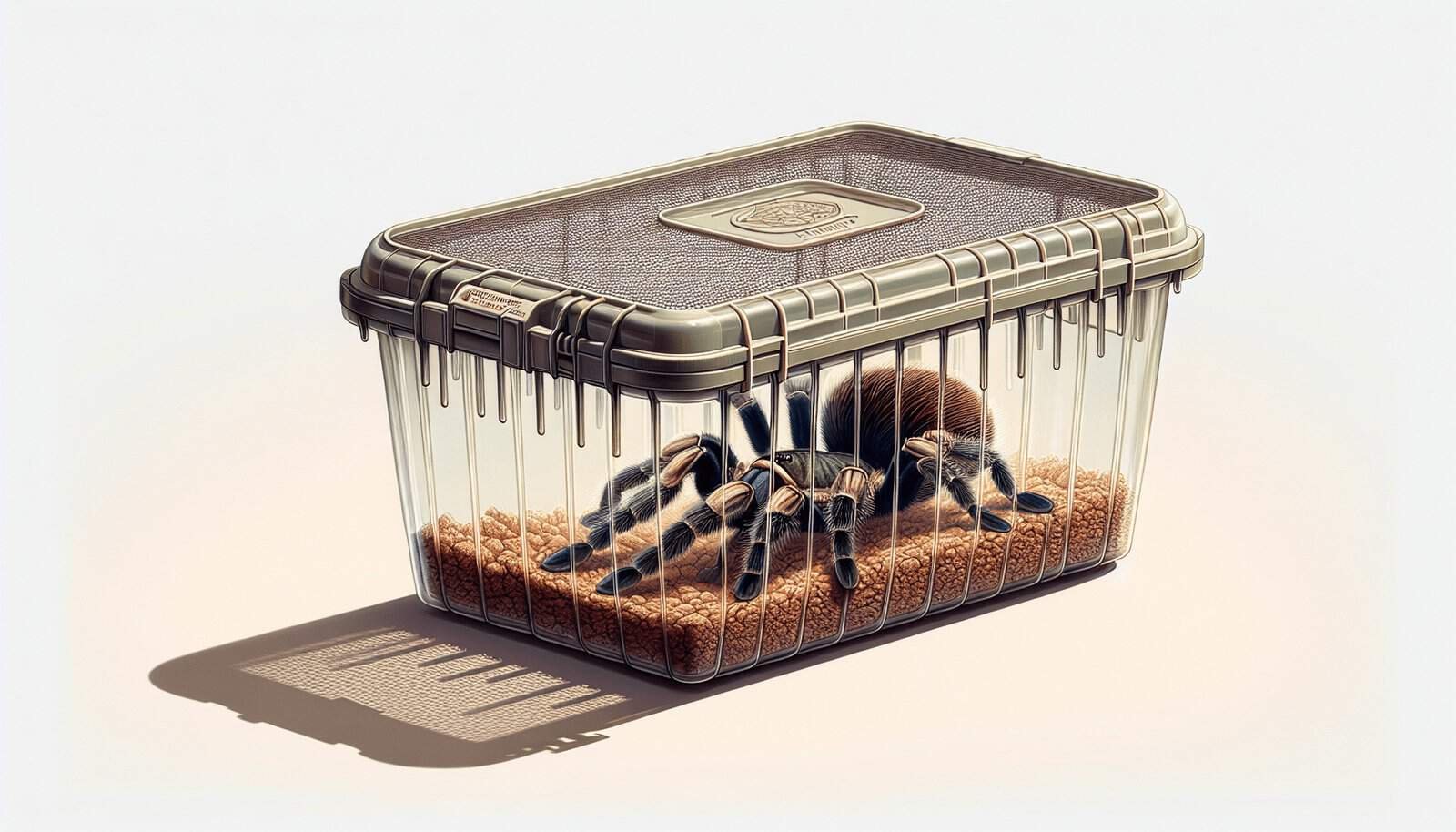So, you’re curious about how to transport a tarantula? Whether you’re a tarantula enthusiast or just find yourself in a situation where you need to move one of these eight-legged creatures, it’s important to know the proper way to do so. Handling a tarantula can be intimidating, but with a few simple tips and precautions, you can ensure a safe and stress-free transport for both you and your hairy friend. Let’s explore the essentials of transporting a tarantula and get you on your way to successfully moving these fascinating creatures.
Choosing the right container
When it comes to transporting your tarantula, choosing the right container is of utmost importance. Consider the size of your tarantula and ensure that the container you select provides enough space for it to move comfortably. A container that is too small can cause stress to your tarantula, while a container that is too large may increase the risk of injury during transport.
In addition to size, it is crucial to select a container that is secure and ventilated. Tarantulas can be skilled escape artists, so make sure the container has a secure lid or closure mechanism to prevent any unexpected adventures. Proper ventilation is also vital to ensure your tarantula can breathe properly during the transport.
Another aspect to consider when choosing a container is to avoid those with sharp edges or openings. Tarantulas have delicate exoskeletons that can be easily damaged by rough surfaces. Opt for a container with smooth edges and a secure lid that will keep your furry friend safe and sound throughout the transport.
Finally, line the container with a suitable substrate. This will provide a comfortable surface for your tarantula to rest on and prevent any potential slipping or sliding during the journey. In the wild, tarantulas are accustomed to burrowing into substrates, so providing a similar environment can help reduce stress during transport.
Preparing the tarantula for transport
Once you have the perfect container for your tarantula, it’s essential to ensure that your eight-legged friend is adequately prepared for the journey ahead. Handling the tarantula with care is crucial to prevent any unnecessary stress or injuries. Remember, tarantulas are delicate creatures with fragile exoskeletons, so gentle and cautious handling is a must.
Before transporting your tarantula, make sure it is well-fed and hydrated. A full and content tarantula is likely to be calmer during the journey, reducing the risk of unnecessary stress. Additionally, ensuring your tarantula has access to fresh water before the transport is important for maintaining hydration levels. Remember to place a small water dish in the container for the duration of the journey as well.
Allow the tarantula to acclimate to the transport container before sealing it. Give them some time to explore their enclosure and feel comfortable within the new environment. This will help them adjust and reduce their stress levels. Patience is key during this process, as each tarantula may need different amounts of time to get comfortable before the transport.
Securing the container
To prevent any accidents or escapes during the transport, it is crucial to ensure that the container is tightly sealed. Double-check the lid or closure mechanism to confirm it is secure and won’t accidentally open during the journey.
Adding padding to the container is another necessary step in securing your tarantula’s safety. This will prevent any movement or shifting of the tarantula within the container, reducing the risk of injury. Soft materials such as tissue paper or crumpled paper towels can be placed around the sides of the container to provide cushioning. However, avoid using any materials that may have harmful chemicals or dust particles that could harm your tarantula.
To further protect the container and its contents, place it in a sturdy and secure bag or box. This extra layer of protection will help prevent any accidental bumps or impacts during transportation. Remember, even though your tarantula may seem calm and sedentary, unexpected movements or accidents can still occur, so it’s best to be prepared.
Managing temperature and humidity
Tarantulas are highly sensitive to temperature and humidity variations, so maintaining suitable conditions is vital to their well-being during transport.
Firstly, it’s essential to maintain a suitable temperature range. Most tarantulas prefer temperatures between 70-85 degrees Fahrenheit (21-29 degrees Celsius). Avoid exposing your tarantula to extreme temperatures, both hot and cold, as this can be detrimental to their health. If you’re transporting the tarantula in extreme weather conditions, consider using insulated materials to help regulate the temperature within the container.
Secondly, monitor and regulate humidity levels. While specific humidity requirements vary between tarantula species, the general rule of thumb is to keep humidity levels between 60-70%. This can be achieved by lightly misting the substrate or adding a small damp sponge to the container. However, ensure that the container is not overly humid to prevent mold growth or respiratory issues for your tarantula.
Throughout the transport, be cautious not to expose your tarantula to direct sunlight or sudden temperature and humidity fluctuations. These rapid changes can cause stress and potentially harm your tarantula’s delicate respiratory system.
Transporting the tarantula
Now that you have taken all the necessary precautions, it’s time to transport your tarantula safely.
Keep the tarantula container upright at all times. This will help prevent any unnecessary stress or potential harm to your tarantula. Tarantulas are adapted to moving in a specific orientation, and tilting the container can disrupt their balance and cause discomfort.
During transportation, it’s crucial to minimize vibrations and sudden movements. Tarantulas are sensitive to vibrations, and constant shaking or jostling can stress them out. Ensure that the container is securely placed and avoid any rough handling or sudden changes in motion.
Additionally, avoid exposing the tarantula to direct sunlight or extreme temperatures. Direct sunlight can quickly heat up the container, causing discomfort and potentially harming your tarantula. Likewise, extreme cold can be equally harmful. It’s best to choose a shaded and temperature-controlled area for transporting your tarantula to maintain a stable environment.
Legal considerations
Before transporting a tarantula, it’s important to be aware of any local regulations or restrictions regarding the keeping and transportation of exotic pets. Different countries, states, or even cities may have specific laws regarding the transport of tarantulas.
Check the local regulations and ensure you comply with any necessary permits or licenses required for transporting your tarantula. Some areas may have restrictions on certain tarantula species or require special documentation. Stay informed to avoid any legal issues during the transport.
Ensure that you have proper documentation for transport, such as proof of ownership, health certificates, or permits if needed. Having the necessary paperwork not only keeps you compliant with the law but also provides reassurance in case of any unexpected encounters during the journey.

Safety precautions
When handling and transporting a tarantula, it’s crucial to prioritize safety for both yourself and your spider friend.
Wearing protective gloves and clothing can offer an added layer of protection. Gloves can help prevent accidental bites, and long sleeves can prevent any accidental contact with the tarantula. While most tarantula species are not aggressive, it’s always best to be cautious and minimize any potential risks.
Avoid direct contact with the tarantula unless necessary. While tarantulas are generally harmless to humans, their urticating hairs can cause irritation or allergic reactions in some individuals. By minimizing direct contact, you reduce the risk of exposure to these hairs. If handling is required, make sure to wash your hands afterward to remove any potential irritants.
Emergency measures
Even with all the necessary precautions, accidents can still happen. It’s important to be prepared and have a plan in case of emergencies during the transport of your tarantula.
First and foremost, prepare a first aid kit specifically tailored for tarantula emergencies. This kit should include items such as antiseptic solution, sterile cotton swabs, styptic powder to stop bleeding, and fine-tipped tweezers for handling any potential injuries. Being equipped with these supplies can help address minor issues promptly and prevent further complications.
Additionally, it’s vital to know the location of the nearest veterinarian who specializes in exotic species. In case of any serious or unforeseen health issues, having quick access to professional assistance can make all the difference. Research and keep the contact information of a reputable exotic animal veterinarian handy in case you need immediate assistance.

Additional tips and advice
Transporting a tarantula can be a nerve-wracking experience, especially if you’re new to tarantula keeping. Here are some additional tips and advice to make the process as smooth as possible.
Firstly, do thorough research on the specific needs of your tarantula species. Different species may have unique requirements, such as temperature, humidity, or handling preferences. Understanding these needs will help you create a suitable transport environment and minimize any potential stress for your tarantula.
Seek guidance from experienced tarantula keepers or experts. They can provide valuable insights and advice on how to handle and transport tarantulas, based on their own experiences. Local tarantula enthusiast groups or online forums can be excellent resources for connecting with knowledgeable individuals who can guide you through the process.
Overall, transporting your tarantula requires adequate preparation, attention to detail, and a focus on your tarantula’s well-being. By following these comprehensive guidelines, you can ensure a safe and stress-free journey for your furry friend, from point A to point B. Your tarantula will thank you for your care and consideration during this exciting but potentially challenging process.



